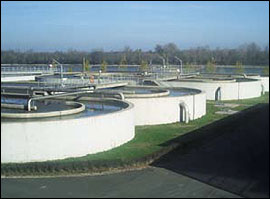 |
A new wastewater treatment plant for the DanubeHungary adds a new facility to its municipal sewage programme. |
 |
The new plant at Dunaújváros
will ensure that wastewater from
60,000 local residents will be clean before it rejoins the river. |
Dunaújváros was the last city without a biological wastewater treatment plant; the project fulfilled a long-standing duty both for the people in the region and for the Danube.
Located approximately 70 kilometres south of Budapest along the
bank of the Danube, Dunaújváros is much like any other medium-sized
town in Hungary. Large-scale industry dominates the town, in particular,
the giant Dunaferr steel works, and the Dunapack paper mill. The town boasts
a population close to 60,000, and one of the busiest ports in Hungary. Water
supply and the removal of sanitary sewage are better than in most Hungarian
towns, but until recently the communal sewage collected was discharged with-out
any treatment to the Danube.
That has changed with the opening in 2002 of a waste-
water treatment plant along the Danube, a project that was long needed and
a long time in prepara
tion. Ferenc Papp, who worked as Technical Designer and Engineer on the
project from 1994 to 2002, says the project was long needed: “In Hungary,
along the
Danube, Dunaújváros was the last city without a biological
wastewater treatment plant, therefore the project
fulfilled a long-standing duty both for the people in the region and for
the Danube.”
Finding support.
Construction of the plant was made possible through decisions of the Central
Transdanubian District Water Authority and the government to protect the
Danube from harmful pollution. With support of the PHARE Programme of the
European Community and under supervision by World Bank experts, a feasibility
study for municipal sewage treatment was prepared for six county-status
towns including Dunaújváros.
The funds for the new wastewater plan were provided
by the International Bank for Reconstruction and Deve
lopment, and the Commission of the European Communities,
and the plant was finally completed in 2002.
Meeting technical specifications.
The new plant is situated on the Danube and includes
mechanical and biological wastewater treatment, as well as sludge treatment
by homogenisation and
thickening. The plant is capable of handling the average
and extreme hydraulic and sewage loads.
To improve the efficiency of the system it was nec-essary to upgrade the
old mechanical plants, to reconstruct
the pressure pipes, and to respond with new operational expectations such
as septic sludge collection,
an outlet in the stream line of the Danube river, a laboratory for controlling
plant operation and environmental
monitoring.
One of the challenging features of the project proved to be the site’s
location. Built directly on the riverside at the foot of a loess hill, the
main sewer had to lead down to the river and the site of the plant had to
be filled in artificially. “This presented several challenges
for construction, as it was necessary to take into account the sensitive
stability of the hillside,” says Papp.
This new facility is one of the success sites along the Danube that will
provide much needed sewage treatment
to fill in a blank in Hungary’s wastewater programme,
reducing human impacts on the environment and protecting the Danube.